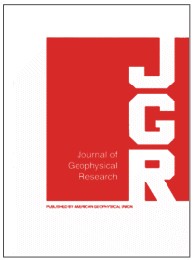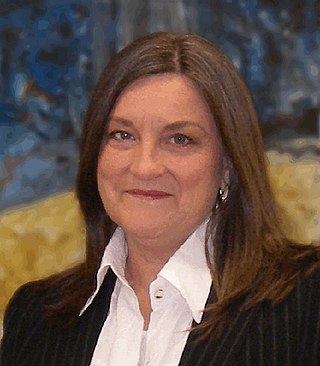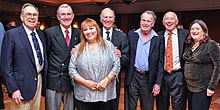
Cluster II is a space mission of the European Space Agency, with NASA participation, to study the Earth's magnetosphere over the course of nearly two solar cycles. The mission is composed of four identical spacecraft flying in a tetrahedral formation. As a replacement for the original Cluster spacecraft which were lost in a launch failure in 1996, the four Cluster II spacecraft were successfully launched in pairs in July and August 2000 onboard two Soyuz-Fregat rockets from Baikonur, Kazakhstan. In February 2011, Cluster II celebrated 10 years of successful scientific operations in space. In February 2021, Cluster II celebrated 20 years of successful scientific operations in space. As of March 2023, its mission has been extended until September 2024. The China National Space Administration/ESA Double Star mission operated alongside Cluster II from 2004 to 2007.

A Birkeland current is a set of electrical currents that flow along geomagnetic field lines connecting the Earth's magnetosphere to the Earth's high latitude ionosphere. In the Earth's magnetosphere, the currents are driven by the solar wind and interplanetary magnetic field and by bulk motions of plasma through the magnetosphere. The strength of the Birkeland currents changes with activity in the magnetosphere. Small scale variations in the upward current sheets accelerate magnetospheric electrons which, when they reach the upper atmosphere, create the Auroras Borealis and Australis. In the high latitude ionosphere, the Birkeland currents close through the region of the auroral electrojet, which flows perpendicular to the local magnetic field in the ionosphere. The Birkeland currents occur in two pairs of field-aligned current sheets. One pair extends from noon through the dusk sector to the midnight sector. The other pair extends from noon through the dawn sector to the midnight sector. The sheet on the high latitude side of the auroral zone is referred to as the Region 1 current sheet and the sheet on the low latitude side is referred to as the Region 2 current sheet.

The Journal of Geophysical Research is a peer-reviewed scientific journal. It is the flagship journal of the American Geophysical Union. It contains original research on the physical, chemical, and biological processes that contribute to the understanding of the Earth, Sun, and Solar System. It has seven sections: A, B, C (Oceans), D (Atmospheres), E (Planets), F, and G (Biogeosciences). All current and back issues are available online for subscribers.

The magnetosphere of Jupiter is the cavity created in the solar wind by Jupiter's magnetic field. Extending up to seven million kilometers in the Sun's direction and almost to the orbit of Saturn in the opposite direction, Jupiter's magnetosphere is the largest and most powerful of any planetary magnetosphere in the Solar System, and by volume the largest known continuous structure in the Solar System after the heliosphere. Wider and flatter than the Earth's magnetosphere, Jupiter's is stronger by an order of magnitude, while its magnetic moment is roughly 18,000 times larger. The existence of Jupiter's magnetic field was first inferred from observations of radio emissions at the end of the 1950s and was directly observed by the Pioneer 10 spacecraft in 1973.

Andrew Emory Dessler is a climate scientist. He is Professor of Atmospheric Sciences and holder of the Reta A. Haynes Chair in Geoscience at Texas A&M University. He is also the Director of the Texas Center for Climate Studies. His research subject areas include climate impacts, global climate physics, atmospheric chemistry, climate change and climate change policy.
Ramón E. López is a Puerto Rican physics professor at the University of Texas at Arlington whose research focuses on space physics and science education. He is an elected fellow of the American Physical Society (1999) and the recipient of its 2002 Dwight Nicholson Medal for Outreach for his contributions to science education. He is also an elected fellow of the American Association for the Advancement of Science (2011).
Eberhard Grün is a German planetary scientist who specialized in cosmic dust research. He is an active emeritus at the Max Planck Institute for Nuclear Physics (MPIK), Heidelberg (Germany), research associate at the Laboratory for Atmospheric and Space Physics (LASP) in Boulder (Colorado), and was a professor at the University of Heidelberg until his retirement in 2007. Eberhard Grün has had a leading role in international cosmic dust science for over 40 years.

Margaret Galland Kivelson is an American space physicist, planetary scientist, and distinguished professor emerita of space physics at the University of California, Los Angeles. From 2010 to the present, concurrent with her appointment at UCLA, Kivelson has been a research scientist and scholar at the University of Michigan. Her primary research interests include the magnetospheres of Earth, Jupiter, and Saturn.

Emma J. Bunce is a British space physicist and Professor of Planetary Plasma Physics at the University of Leicester. She holds a Royal Society Wolfson Research Merit Award. Her research is on the magnetospheres of Saturn and Jupiter. She is principal investigator (PI) of the MIXS instrument on BepiColombo, was deputy lead on the Jupiter Icy Moons Explorer proposal, and co-investigator on the Cassini–Huygens mission.

Mei-Ching Hannah Fok is a planetary scientist at the Goddard Space Flight Center. She was awarded the NASA Exceptional Scientific Achievement Medal in 2011 and elected a Fellow of the American Geophysical Union in 2019. She has worked on the IMAGE, Van Allen Probes and TWINS missions.

Nancy U. Crooker is an American physicist and professor emerita of space physics at Boston University, Massachusetts. She has made major contributions to the understanding of geomagnetism in the Earth's magnetosphere and the heliosphere, particularly through the study of interplanetary electrons and magnetic reconnection.

George L. Siscoe was an American physicist and professor emeritus of space physics at Boston University. He made major contributions to the understanding of the Earth's magnetosphere and the heliosphere, particularly in helping to establishing the field of space weather and the term heliophysics - a term which is now standard use.
David Breed Beard was a space physicist, known for "pioneering work on the shapes and structures of planetary magnetospheres, Jovian radio emissions, and comets."
Wen Li is a space physicist at Boston University. Her research interests include space plasma waves, Earth's radiation belt physics, solar-wind magnetosphere coupling, energetic particle precipitation, and Jovian magnetosphere and aurora: She is a Fellow of the American Geophysical Union.
Meers Oppenheim is an American physicist who is Professor of Astronomy at Boston University. His primary research interests include computational and theoretical space plasma physics, dynamics of the ionosphere and solar atmosphere, particle-wave interactions in plasmas, and the physics of meteor trails.
Lynn Kistler is a physicist known for her research on the magnetosphere that protects Earth from radiation from space.

Patricia Reiff is an American space physicist at Rice University, known for her research on space weather and for engaging the public about science.
Mary Hudson is the Eleanor and Kelvin Smith Distinguished Professor of Physics at Dartmouth College. She is known for her research on the weather patterns that occur due to solar eruptions. She was elected a fellow of the American Geophysical Union in 1984.
Michelle F. Thomsen is space physicist known for her research on the magnetospheres of Earth, Jupiter, and Saturn.

James Wynne Dungey (1923–2015) was a British space scientist who was pivotal in establishing the field of space weather and made significant contributions to the fundamental understanding of plasma physics.












